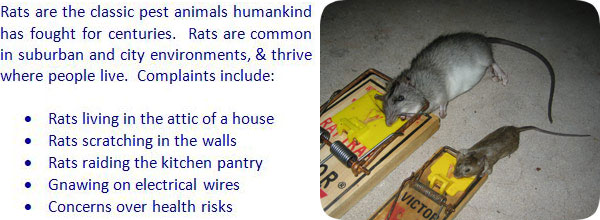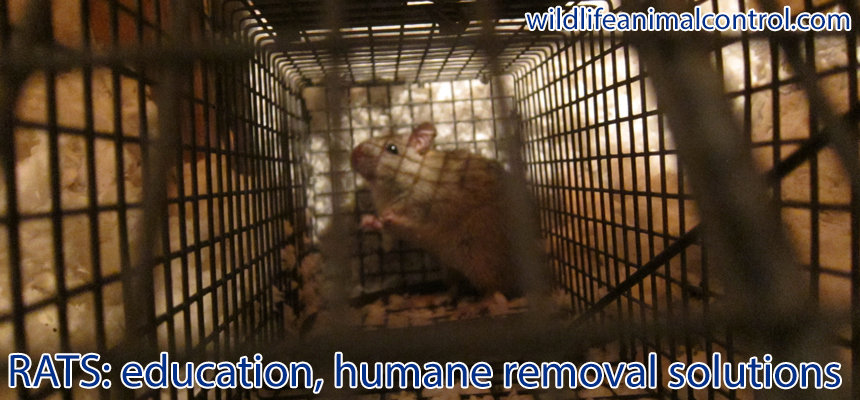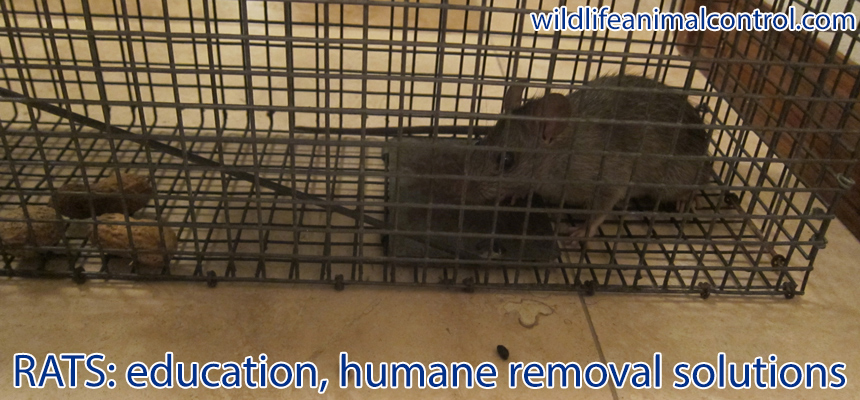- info@wildlifeanimalcontrol.com
Call us for help in your town
Wildlife Control Education
How to Get Rid of Rats in the Attic

We provide PERMANENT rat removal in over 1700 USA locations - serving the whole USA.
It is my goal to educate the public about rats and other wildlife, and
provide tips for safe, effective, and responsible wildlife removal. Remember, to solve many rat problems, the best
bet is prevention and sealing shut entry holes: inspect your house to find animal entry holes.
Summary of Step-By-Step Instructions:
1) Inspect inside attic, and ever square inch of the house, for rat entry holes. These holes can be as small as a quarter, or a 1/2" wide gap.
2) Seal shut all entry holes, with steel, BEFORE any trapping or exclusion.
3) Set one-way exclusion funnels on the primary entry/exit holes, or set at least a dozen rat traps, baited with peanut butter, on the primary rat trails (marked by droppings and brown grease) in the attic.
4) Once you hear no more rat sounds at night, the trapping is complete.
5) Clean and decontaminate the attic space.
Need rat removal in your hometown? We service over 500 USA locations! Click here to hire us in your town and check prices - updated for year 2020.
How to Get Rid of Rats - There are many methods - poisoning, snap traps, exclusion, repellents, etc. But in my 10+ years working in rat control, I have DEFINITELY learned that only one thing matters - you must find out how the
rats are getting inside the building, through holes, gaps, vents, etc, and seal these areas shut. Nothing else matters. Once the whole house is sealed shut with steel repairs, then you must physically trap and remove the rats.
Information about rat trapping - analysis and methods for how to trap. Any other method is a waste of time.

Rats are one of the most feared animals in the industrialized world because they can destroy your home and can have fleas and ticks that carry harmful diseases like the plague. Rats are often mistaken for mice, but they are very different. Rats are bigger, have larger feet and do more damage. However, like mice, rats can come in a variety of different colors and species and have long hairless tails. The most common species of rats that infest homes include roof rats and Norway rats.
Diseases aside, rats will do a number on your home. They will eat their way into your pantry and contaminate your food by leaving droppings in things like sugar, flour and in cereal boxes which, as you can imagine, is not sanitary. Rats will gnaw their way into anyplace in your house that they want to go which can damage your drywall, your wall studs, electrical wiring and even plumbing. Rats have been the catalyst in many house fires by chewing on wires and bringing nesting materials like twigs, twine and leave which are extremely flammable and will light up your entire house with even the smallest of sparks.
There are many ways to tell if you have a rat infestation and this is also the first step in getting rid of them. There will be urine streaks along your walls and areas where the rats frequent. If you do not readily see the marks, then you can buy a black light and find them that way. The easiest way to tell if you have a rat problem is by chew marks around your cabinets and in food bags and boxes. They also chew holes over two inches into your walls. If you have noticed these tell-tale signs of a rat infestation, here are some tips for you to get rid of them for good:

- Clean your house! Clutter is a rat's best friend and they will often hide and reproduce in piles of clutter and this includes the clutter in your attic, basement and closets. Clutter doesn't even have to be bags, boxes and fabric because rats can even chew through some metals and squeeze through holes that are only a half an inch wide. Also, make sure that your kitchen floors are clean and your main and bathroom trash is dumped regularly. Eliminating their food sources eliminates their desire to hang around your house. Information about how to keep rats away - prevention techniques.
- Poisons. Rat poison is the least effective, though cheapest way to try get rid of rats. However, you should use the poison as a last resort because poisons cause rats to die in areas that are hard to get to and they will rot in your walls attracting all kinds of insects and leaving a horrible smell. And this doesn't solve the root of the problem. Information about how to kill a rat - with fumigants or poison.
- Attract natural predators of rats to your home. You can get a dog or a cat to deter the rats away, but this doesn't always work. The most effective predator of keeping the rat population to a minimum is owls. Try to build a nesting box to attract them to your home, but they will not help with the rats already in your home.
- Call in the professionals. The easiest, but the most expensive, way to eradicate your rat problem. Exterminators are extremely good at what they do and can get all the rats out of your home in a matter of days.
- After you can gotten rid of the rats either by yourself or by a professional you will need to close all the entry ways that they use to get into your home. This is very time consuming and will require that you comb every inch of your house. If you skip this step, the rats will come back so make sure that you do it!
More in-detail how-to rat removal articles:
Information about how to catch a rat - remove one stuck in the house.
Information about rat repellent - analysis of types and effectiveness.

Rat Information & Facts
Rat Appearance: Rats are rodents of medium size, measuring up to twenty inches from nose to tail. Rats vary in color with the most common pigments seen being brown, gray, and black. These rodents look like large versions of mice, though there are some differences between the two. Rats are always larger than mice, with more block-like heads and small ears. House mice have ten nipples and rats have twelve. Rats tend to have coarse, long fur which is often moist with enough oils to leave noticeable grease marks around the environment. Depending on the species, a rat's tail can be longer than the length of the body or slightly shorter. The most common species of rats are the Black Rat and the Norway (Brown) Rat.
Rat Habitat and Behavior: Found everywhere in the world except the Antarctic, the rat is the most successful species after mankind. Brown and Black rats are found anywhere humans live in number, and it is suspected that the number of rats outnumber people in most cities. Rats originated in Asia, and were a source of food for many people living on the plains and grasslands. Excellent burrowers, rats can create a network of multi-level tunnels, using these burrows to sleep, store food, and raise young. Rats in the wild still abide by this standard of living, usually constructing their dens near a sturdy object for structural support. This may be the secondary reason rats evolved to live near people. The primary reason is most likely the readily available food sources in human dwellings. In nature, rats will live in damp areas around water, presumably due to the instinctual survival instinct associated with hydration. The rodents are excellent swimmers and water may also provide a means of escape if an enemy approaches the burrow. Rats in cities are commonly found in sewage systems. In the rural setting, these large rodents will often commune in attics or basements, creating a network of pathways through the interior of a home.
Like many pack animals, rats will live in communities based on a social hierarchy. These groups are divided into male and female sub-groups. Females in a pack, also known as a mischief, will experience estrus at the same time and have up to five litters in a twelve month period. The social standing of a rat will determine its survival rate, as most animals lower on the totem pole will receive the least amount of food when a source is found.

Rat Diet: If it is edible, a rat will most likely eat it. This undiscerning palate is the reason why rats follow humans and live in close proximity. In nature, rats will catch small fish, birds, and will even swim underwater for various shellfish.
Rat Nuisance Concerns: Homes with a rat infestation run a serious risk of fire from damage caused by chewing. These rodents also destroy insulation, support boards, ductwork, and cabinetry. A rat can chew through almost any porous substance, making it near impossible to keep the creatures out of food containers and boxes. A rat in the home will leave feces and urine wherever it goes, and this waste excretion is a major sanitation issue for pets and people. Rats are also large enough to be very intrusive with noise from nocturnal activity, and most of our calls regarding these rodents is due to scratching sounds in the attic or walls from the rats running around.
Rat Diseases: A number of diseases can be transmitted through rats, most of which are carried in the animal's waste. Salmonella, Typhus, leptospirosis, and Rickettsia Disease are just a few diseases humans can get from rats. The Bubonic Plague, which wiped out a third of Europe's population, was spread by fleas transported on rats. The plague is still active in some areas of the United States and Europe. Learn about how to clean attic of animal waste.
You're here to learn how to get rid of rats in your house, the attic, ceiling, walls, roof, etc. This site is intended to provide rat education and information, so that you can make an informed decision
if you need to deal with a rat problem. This site provides many rat control articles and strategies, if
you wish to attempt to solve the problem yourself. If you are unable to do so, which is likely with many
cases of rat removal, please go to the home page and click the USA map, where I have wildlife removal experts
listed in over 500 cites and towns, who can properly help you with your nuisance rat.
Read more of my articles about rats, written based off of my years of professional experience. I can show you how to get rats out of the garage or car, and how to use one way exclusion funnels to remove rats without trapping them. Let me show you what rat feces look like and what rats can climb. Learn why using poison causes dead rats inside the house and if rats are dangerous to cats, dogs, or other pets. Find out if a rat will chew through the ceiling and what you should do with a rat after you catch it. I can show you how to get rats out of your bedroom or attic and can show you the kind of damage rats can cause. Learn why they can fit into such small holes and if rats carry rabies. Learn the first steps to take if a rat gets inside your house as well as how to find and remove a dead rat. Learn where to relocate a trapped rat and what Property Modifications will help keep down rat populations. Read my thoughts on if you should hire a pro, or remove rats yourself and if you should ever poison a rat.
Learn how rats can get into buildings through the Plumbing and if homeowners insurance will pay for rat damage. Become familiar with the kinds of sounds rats make and the risk that a rat in the attic will have a nest of babies. Read about what wildlife rehabilitators do with rats and some humane ways to kill a rat. Learn if rats hibernate and if repellents will get rats out of the attic. I can let you know if city or county animal services will help with a rat issue, and what exactly rodents can Chew Through. Find out if a strobing light or high pitch sound will work against rodents, and what you should do with a rodent after you catch it. Find out how to prevent rodents from chewing on car wires and how to get rats out of a wall, as well as how to keep them out of your garbage. Learn how poison works and how to remove a rat stuck in a dumpster. Read about the rat problem in New York City, the rat's mating habits, how smart they are, and the symptoms of a sick rat. Learn about the different types of Snap Traps, if rats bite sleeping babies, and what to do about a trap-shy rat or even one on the roof.

















